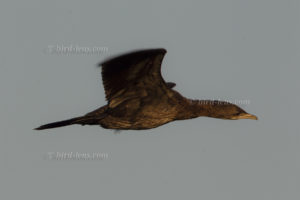 In size between a Eurasian Coot (Fulica atra) and a Great Cormorant (Phalacrocorax carbo) and black as well. Pygmy Cormorants are increasingly a sighting in Germany. Right now, a Pygmy Cormorant has been reported from Stotternheimer See near Erfurt. Several images show, as the Pygmy Cormorant swims, rest and starts from the water in front of reeds on this lake in Thuringia. Before, this species – maybe the same bird – was reported from the southern bay of Sulzer Lake which is also close to Erfurt. The bird was always good to see from the 3rd to the 11th of December 2018. Pygmy Cormorants found in Thuringia fit very well into the picture of a more frequent occurrence of the bird species in Central Europe starting from the years 2000, as reports from the Netherlands, Austria, Switzerland, from the Bodensee and from Germany. Scientists suspect that this phenomenon can be explained by the large increase in the breeding population in the Hortobágy in Hungary. The species seems to occur increasingly in Germany in the second half of the year – especially in late autumn and winter.
In size between a Eurasian Coot (Fulica atra) and a Great Cormorant (Phalacrocorax carbo) and black as well. Pygmy Cormorants are increasingly a sighting in Germany. Right now, a Pygmy Cormorant has been reported from Stotternheimer See near Erfurt. Several images show, as the Pygmy Cormorant swims, rest and starts from the water in front of reeds on this lake in Thuringia. Before, this species – maybe the same bird – was reported from the southern bay of Sulzer Lake which is also close to Erfurt. The bird was always good to see from the 3rd to the 11th of December 2018. Pygmy Cormorants found in Thuringia fit very well into the picture of a more frequent occurrence of the bird species in Central Europe starting from the years 2000, as reports from the Netherlands, Austria, Switzerland, from the Bodensee and from Germany. Scientists suspect that this phenomenon can be explained by the large increase in the breeding population in the Hortobágy in Hungary. The species seems to occur increasingly in Germany in the second half of the year – especially in late autumn and winter.
Pygmy Cormorants are in fact small relatives of the European Cormorant, which are increasingly, but still very rarely observed in Germany. The Pygmy Cormorant is about 45 to 60 centimeters long and weighs 700 grams. Pygmy Cormorants occur in Europe, especially in Russia, Greece, Turkey and Romania and nestset mainly in colonies. The European breeding bird population is estimated at between 28 and 38,000 breeding pairs. The population is internationally endangered.
To cope with the growing demand for top shots of the rarer species of the Palearctic Bird-Lens is keen to enrich the range of pictures of birds you can find in the western palearctic. Trips to remote places like this one to capture images not only of rare birds of western palearctic were very successful. The nice image of the blog is only a first impression, what you will find in the gallery in the “Picture Shop” very soon. Just give me a message, if www.bird-lens.com could serve you with an image needed before the new pictures are online.